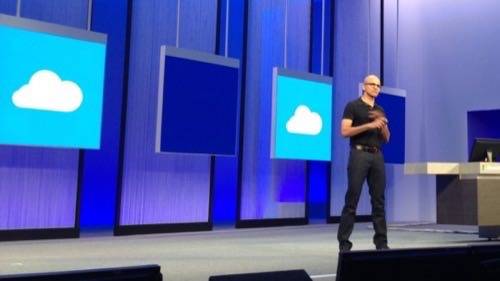
ReadWritePredict is a look ahead at the technology trends and companies that will shape the coming year.
Pour your coffee, sit down, and log in: It’s the routine of hundreds of millions of knowledge workers.
As businesses add a crazy quilt of online services to the tools we use, those logins keep piling up. Information-technology managers—when they don’t just throw up their hands—have long dreamed of a nirvana called single-sign-on, where one login rules all. And increasingly, those login credentials will live up in the cloud, managed by some Web giant.
Three companies are on a collision course, jostling for control of the keys to our professional identity. They are Google, Microsoft, and LinkedIn.
The Google Way
Google Apps is the primary way Google insinuates itself into a business. For $5 per user per month, Google offers email, storage, collaborative documents, and more. All of that comes with a Google Account—the key to other Google services, as well as apps that have integrated with Google. (Google recently eliminated some roadblocks to using Google Apps as a login.)

The tradeoff with going Google is that some of Google’s initiatives—for example, pushing Google+, its don’t-call-it-a-social-network thing that lets you connect and share with friends online—may clash with the sensibilities of corporations.
Yet the integration of Google accounts with Android apps may appeal to those looking to mobilize their workforces. And the price is hard to argue with. The missing piece here is for Google to find a way to make company-specific versions of Google+ that are private and secure for internal information sharing and video chat—and to deal with the frustrations experienced by users who have both personal and corporate Google accounts.
Microsoft’s Cloud Is Rising
While Google may have a head start in Web-based productivity apps, Microsoft is not resting on its big workplace franchise in Exchange email and Office apps. In fact, it may have found a clever, little-noticed way to bring Office users into a vast online directory.

In the 1990s, Microsoft ventured into the dangerous waters of creating a universal Web login when it unveiled Hailstorm, later known as Passport. After a torrent of brickbats from privacy and antitrust activists, Microsoft retreated—but Passport quietly lived on, eventually becoming the Microsoft Account, the service people use to log in to Windows today.
There’s a little-known enterprise version of the Microsoft Account called Windows Azure Active Directory. It is a version of the directory tools Microsoft has long offered to businesses—but up in the cloud, in one big database of employee logins. If you use Office 365, you have an Azure Active Directory account.
At a press event in October, Microsoft’s cloud chief, Satya Nadella, one of the internal candidates to become the company’s next CEO, unveiled a vision for how Microsoft could bring together its powerful desktop-software franchise and its budding cloud services.
“Every time someone signs up for Office 365, they’ve populated Azure Active Directory,” Nadella noted. Microsoft is also encouraging It managers to sync their old-school “on-premises” directory servers with Azure, adding to the accounts Microsoft tracks. Microsoft says it has 2.6 million organizations and 261 million users in Azure Active Directory.
Nadella mused about the “notion of having an enterprise directory that’s fully programmable and accessible through interfaces” to software developers. In other words, that Microsoft login might not just be the tools to your work email and Office apps online—it might become the way you access hundreds of third-party apps, especially on devices running Windows 8 or Windows Phone. Already, Microsoft integrates Azure Active Directory with Salesforce, Dropbox, Box, and other apps.
Don’t count out Yammer, either. While the online-collaboration tool has mostly been quiet as a subsidiary of Microsoft, which acquired it last year, it had been preparing a big push to lure app developers to use its accounts as logins. Microsoft could revive that strategy, either independently or as an arm of the Azure push.
LinkedIn’s New Connections
If you’re still thinking of LinkedIn as a place to hunt for jobs, catch up: The professional network has been refashioning itself as the hub of its users’ daily work lives.
Right now, LinkedIn users post updates publicly. But LinkedIn CEO Jeff Weiner has been talking about how his employees have access to a special version of the site where they can share updates and collaborate internally—an unreleased competitor to Microsoft’s Yammer.

In 2013, LinkedIn also rolled out a new contact-management feature and a host of mobile apps—including a controversial one, Intro, which essentially inserts LinkedIn as a middleman for your email, adding details about your correspondents to every message.
LinkedIn also owns Slideshare, a tool for sharing business presentations, and runs Pulse, a Web and mobile app that pulls together the news headlines your colleagues and peers are reading.
And for some time, though it’s far less known than, say, Facebook’s tools for logging into apps, it has offered a platform that lets developers log users in using their LinkedIn profiles.
Put it all together, and LinkedIn has many of the same things Microsoft and Google do: a professional identity that’s portable on the Web, and tools for email, contacts, and collaboration around information.
LinkedIn has one key advantage over Microsoft and Google: It is organized around the modern way we work, where not everyone has the same ending to their email address. The network of contractors, vendors, and partners who swirl through our daily lives may not be in the same single-sign-on directory. But odds are they’re on LinkedIn.
Battles Inside And Out
Microsoft and Google, of course, have been in open warfare for some time, and crow about stealing each other’s customers. No surprise there. But it will be interesting to watch if Microsoft insists on keeping Windows Azure Active Directory on Windows Devices—or makes a play to get in the world of Android. That will likely be a test of whether Microsoft’s new Devices group, bolstered by the addition of Nokia’s handset business, has the upper hand—or if Nadella’s cloud army will be triumphant.
Google, too, has its internal battles to fight. Google Accounts are where Google+, Google Apps, and Android all intersect. Google CEO Larry Page has tried to cut down on internecine warfare by pushing out Andy Rubin as Android chief and installing Sundar Pichai, who now oversees Google Apps and Android. And Google+ chief Vic Gundotra has been persuasive in pushing his sharing tools as a “social layer” throughout Google. But making Google’s services work smoothly inside and outside of corporations may require some serious architectural changes—and not all Googlers will be happy about it.
LinkedIn has the least to lose and the most upside here. And one of its virtues may be that it is neither Microsoft nor Google. Already, it has made a very interesting friend in Apple, which welcomed LinkedIn inside its Mac OS X operating system. Though we haven’t seen many examples of apps taking advantage of this, it’s an interesting beachhead that few have taken notice of.
Others Waiting In The Wings
Could others make a play for this market?
Twitter is an obvious contender. It is popular as a login option, particularly with apps that let users generate or share content, like news readers. And many enterprise apps are integrated with Twitter. (Take, for example, the content-management system which published this story on the Web and on Twitter simultaneously.) For many users—particularly journalists, marketers, and celebrities—Twitter has also become their public-facing persona online.
Yet it’s hard to reconcile Twitter’s town-square feel with the cloistered campuses of corporations. Twitter may end up always being a megaphone, not an intercom.
Salesforce, too, is worth watching. In 2012, the software maker launched Salesforce Identity, and it opened up the service to app developers a couple of months ago. It’s less of a source of identity like a Google or Microsoft account, and more of a bridge to various online accounts, but it could grow to become something more.
What’s clear is that becoming the way people log in to work applications is increasingly valuable, as more and more of our tasks shift completely online. Those who check our IDs aren’t just gatekeepers: They hold the keys to hundreds of millions of users who could become customers for the next great enterprise app. As such, the war over professional identity matters to employees, managers, and app developers. It will be an epic contest.
Photo by Flickr user wonderferret










